Practical and economical LED strips are increasingly used in interior design. They often complement or even replace conventional lighting. Dimmed lighting looks unusual and attractive, don't you agree?
Finding products that match the size and characteristics of the luminous flux, as well as convenient controls today is not difficult. Manufacturers, taking into account the great consumer interest, produce LED strips of all types and colors.
In the article, we tried to give as much useful information as possible about the products themselves and related devices, as well as tell in detail how to connect the LED strip in order to maintain its performance and prolong life time.
The content of the article:
- Features of LED strips
- Do I need a power supply and controller?
-
DIY connection instructions
- Option # 1 - a circuit with a power supply
- Option # 2 - installation instructions with a dimmer
- Conclusions and useful video on the topic
Features of LED strips
Everyone is familiar with LED lighting: white, neon, multi-colored contours often illuminate shop windows, advertising and festive structures, dance floors, suspended ceilings. The light comes from flexible strips, inside or outside of which LEDs with accompanying elements are fixed.
Before connecting tapes, you must first familiarize yourself with their variety in order to choose the right products and not make mistakes when connecting devices with each other. And it's better to start with the marking, which is always available for certified products: printed on stickers or directly on individual elements.
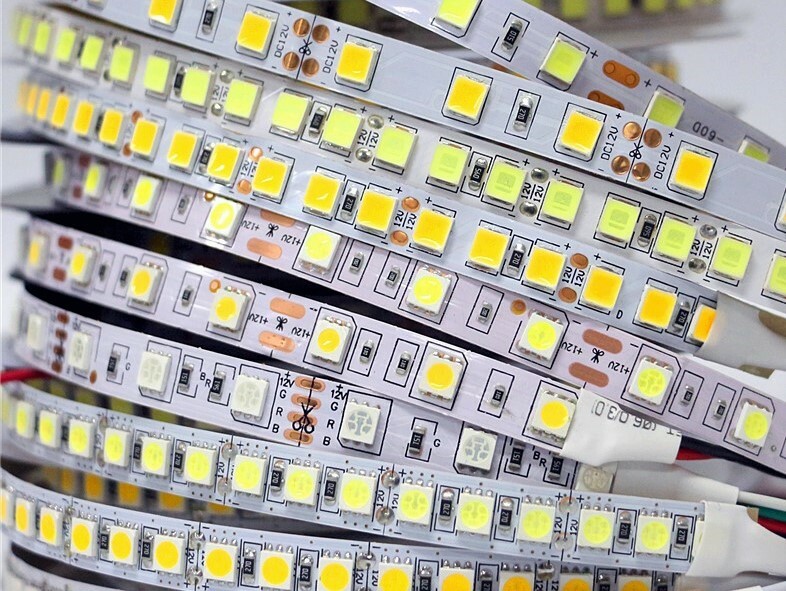
Tapes are distinguished by length, width, number of LEDs, and glow intensity. The uniformity of illumination is achieved with the same quality for all products: the LEDs are located with the same pitch along the entire length
LED Is a general designation for all LED products.
But they can be located in different ways:
- SMD - fixed to the surface;
- DIP LED - are inside a transparent tube or covered with a layer of silicone.
The modules are made in various standards, and the dimensions are encoded in an understandable format:
- 2835 - 28 * 35 mm;
- 5050 - 50 * 50mm, etc.
There is such a thing as the density of modules - the number of LEDs per 1 p / m. Usually these are 30, 60, 120 or 240 pieces.
Glow or color marking is indicated in Latin letters:
- CW - white cold;
- Ww - warm white;
- RGB - with changing color;
- G - green;
- B - blue;
- R - Red.
The protection class is indicated by the standard designation IPxx: IP20, IP65, etc.
For the convenience of choosing, it is better to use pivot tables, which are often offered by the manufacturer.

In this table, you can find parameters useful for calculations if you want to choose the most economical option. Also, for comparison, the equivalent powers of incandescent lamps are presented.
On bays or packages with meter lengths there are stickers indicating the power, voltage, luminous flux parameters for 1 LED.
Long tape can be cut into pieces with scissors, leaving mounting pads on both sides. This is easy to do, since clear symbols are applied along the entire length.
To connect the fragments, either special connectors or soldering are used. The first option speeds up the splicing process, but is more expensive.
Do I need a power supply and controller?
Household voltage is usually 220 V. It is not suitable for an LED strip, therefore, power supplies are used to convert energy. You can find 12 V or 24 V devices on sale - the choice depends on the type of tape.
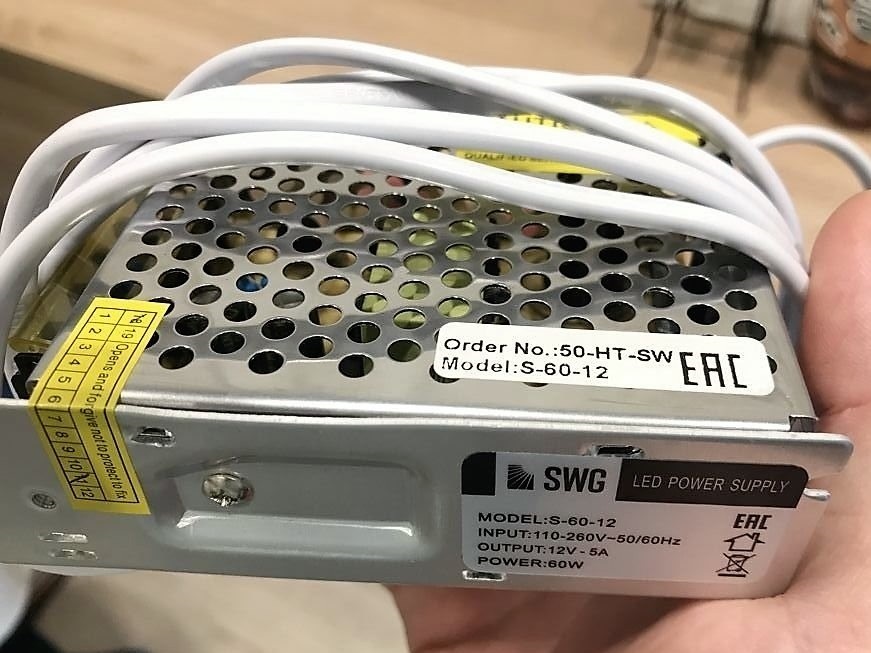
All the necessary technical characteristics of the power supply are indicated on the label. Before connecting, also pay attention to the terminals for connecting the tape and the power cable
In addition to the voltage, it is important to know the total power of the tapes, which will have to be calculated independently. To do this, the power of 1 p / m is multiplied by the total number of meters that are planned to be connected to the power supply unit, and then another 30% is added.
Suppose we have two 4-meter tapes with 4.8 watts, but we want to connect them to the same power supply. 2 x (4 x 4.8) + 30% = 49.92 - therefore, it is better to take a 60W PSU.
A dimmer is a type of controller with which you can adjust the settings for the backlight contour: brightness, color selection, and others. Cheap devices usually work according to one program, for example, they slowly change 2-3 colors. If variety is required, you will have to buy a more expensive device.
Features and dimmer working principle we examined in detail in our other article.
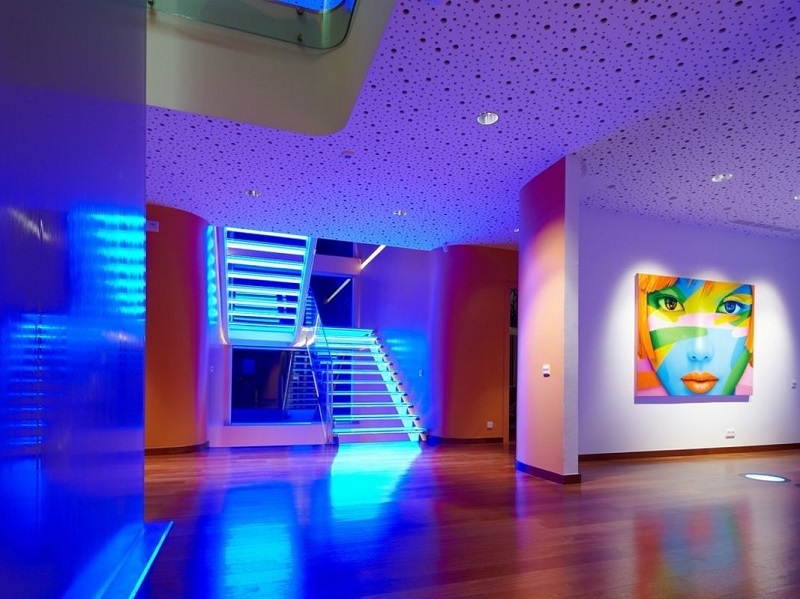
Flickering or neon lighting can be used to create unusual space or rainbow lighting. For him, a dimmer circuit is required
For the comfort of use, the controllers are equipped with remote controls. At choosing a dimmer for LED strip you also need to take into account the power, and it is better to buy a controller with a reserve.
DIY connection instructions
Components for assembly are sold separately, but thanks to the proven circuits, you can independently mount and connect decorative strip lighting.
Consider a few simple and affordable assembly options, thanks to which you will create a full-fledged lighting fixture and diversify the interior.
Option # 1 - a circuit with a power supply
It is best to buy all items in a specialized store or order on one of the proven online sites, after making sure that the products are safe and certified.
For assembly you will need:
- 5 m of LED strip for 12 V with wires for connection, for 1 p / m - 60 LEDs;
- 2 * 0.5 wire for connecting the LED strip and the power supply unit, the length depends on the place where the components are installed;
- wire 3 * 1.5 to connect the power supply to the network of the required length (50-150 cm);
- a collapsible plug for a wire, rated for 10 A;
- switch 6 A - an analogue of a product for night lamps or sconces;
- 60 V power supply.
A construction knife, Phillips screwdriver, electrical tape or heat shrinkage are useful for performing operations. If the mounting pads are not equipped with conductors to connect the fragments, then a soldering iron is needed.
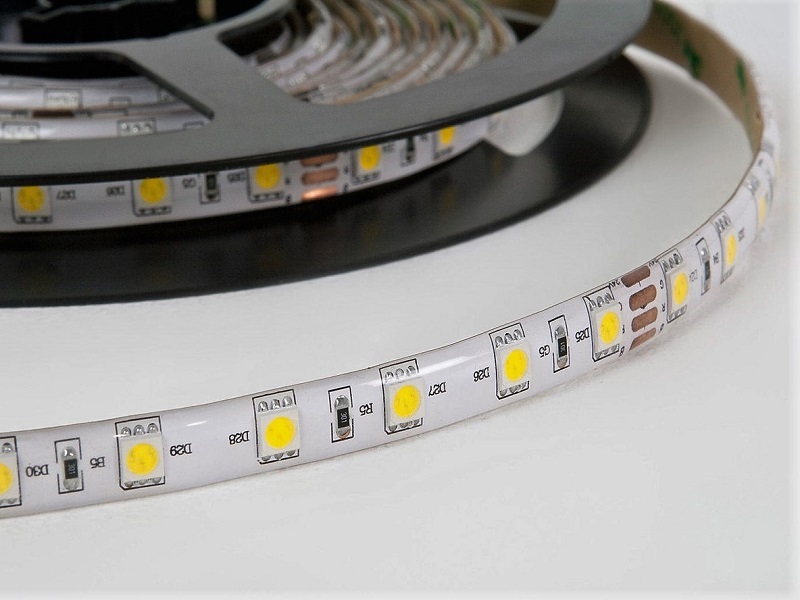
Don't want to waste time on soldering? Buy tape not in separate meter lengths, but in a reel. Winding is different, but the maximum recommended length is 5 meters
In order not to waste money, pre-determine the length of the LED strip and buy a reel with the required winding. To illuminate the ceiling, a considerable length may be required - 15-20 m, and for a mirror much less - 2-4 m.
Step 1 - assembling the power cable
We take the plug, disassemble its case by unscrewing the fixing screw, and take out the pins. Then we strip the conductors of the 3 * 1.5 cord at the ends and insert them into the terminals, which can be located either on the pins or inside the case. We put the pins back into the case, but already together with the attached wires, assemble it and tighten the mounting screw.
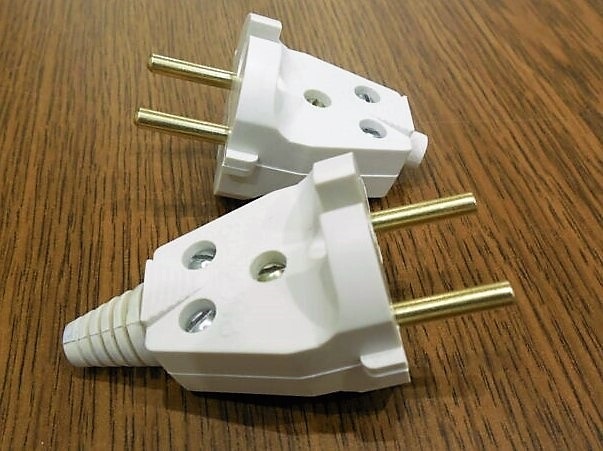
We recommend not to save on any electromechanical devices - the price difference is small, but the quality may differ markedly due to the use of more reliable and safe materials
Step 2 - connect the power cable to the PSU
Terminals required L, N, PE on the back wall of the unit body. We clean and twist the ends of the wire free from the plug. We remove the cover from the case, find the necessary terminals, unscrew the fixing screws.
We twist the bare wires into small rings, put them on the screws, which we then screw into the seats. Do not forget that the conductor with the yellow-green marking is always connected to the PE terminal.
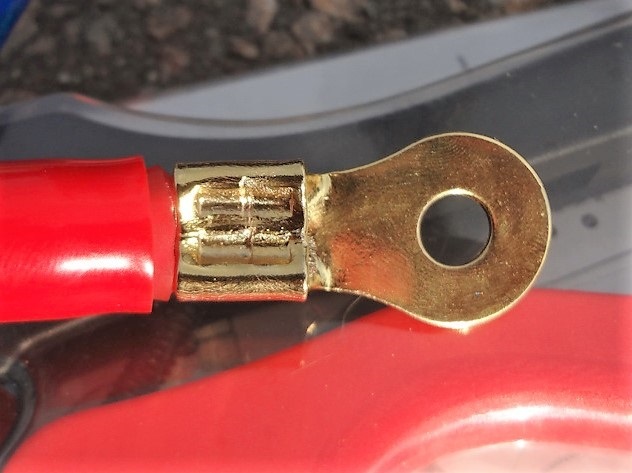
To avoid an unreliable connection method such as twisting, use factory-made terminal lugs. They are easy to put on the bare ends of the wires, secure by pressing and insulate
Step 3 - connect the LED strip to the PSU
We take a 2 * 0.5 wire and strip the ends of the veins on both sides. We connect it to the power supply with one end, and to the LED strip with the other.
Here it is necessary to observe the polarity - this is not difficult if you take into account the color coding: suppose we connect the red conductor to the V + contact, and the black one to V-. The connection to the power supply unit takes place according to the well-known principle: we make rings, put them on the screws, which we screw into the corresponding slots.
If the LED strip is equipped with mounting wires, no soldering is required. We put heat shrinkage on the ends, twist the cores ("+" tapes - with a red conductor, "-" - with a black one), distribute the heat-shrinkable tube at the junction, heat it up. You can use electrical tape. If you prefer soldering to twisting, it will work as well.

Safe and effective way of insulation - when each wire is shrink-wrapped and then both or more wires are covered with another protective layer
Step 4 - testing the backlight
We insert the plug into the outlet and see if the LEDs light up. If the tape is still wound on the spool, we try not to keep it in the on state - we tested it and turned it off.
The next operation is required if you do not want to use the plug every time, but are accustomed to a more convenient method - using a pushbutton switch.
Step 5 - integrating the switch into the power cord
The switches differ in shape and size, but are similar in connection principle. The easiest way to find on sale is white, less often black products. It is best to match the device with the same color as the cord.
We remove the load, that is, we take out the plug from the socket. We disassemble the switch - unscrew the fixing screws.
On the power cable, we mark the installation site, which we consider the most convenient for further operation. We apply marks to remove insulation, focusing on the length of the switch.
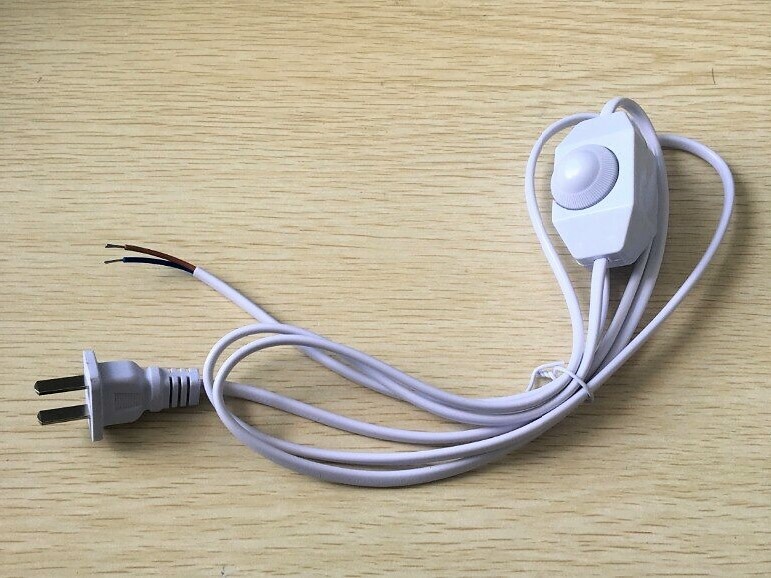
When cutting off the insulation, we take into account that after reassembly it should "go" under the device body, therefore we make the bare section of the wire 1.5-2 cm shorter than the length of the switch
We make cuts on the outer insulation with a knife, while the inner one cannot be touched. Carefully remove the top plastic, find the zero core, cut it in the middle and clean the ends. Do not touch the phase. We twist the protected ends of the wire, insert into the terminals.
We place the second wire, uncut, in parallel, but on the other side. We close and fix the lid. We check whether the external insulation is hidden in the switch body - this is a necessary safety condition.
Step 6 - retesting the backlight
We turn on the plug in the network, check the operation of the switch.
The metal power supply must also be insulated to prevent accidental contact and electric shock. For protection, you can use a plastic box or other casing that does not allow electricity to pass through.

There are non-insulated PSUs on sale, initially placed in a polymer case at the factory. For switching with other devices, they are equipped with wires or terminals
It is possible that after all the above procedures, the tape will not light up. If you exclude the marriage of products, there remains a violation in the assembly scheme. The most common mistake is confusion in the polarity of the connection. It can be corrected by reconnecting the conductors.
Option # 2 - installation instructions with a dimmer
The possibilities of LED backlighting can be significantly expanded if you use a dimmer - a device with with which you can adjust the brightness of the lighting, set the flicker, set the change program colors. It is often sold paired with a remote control.
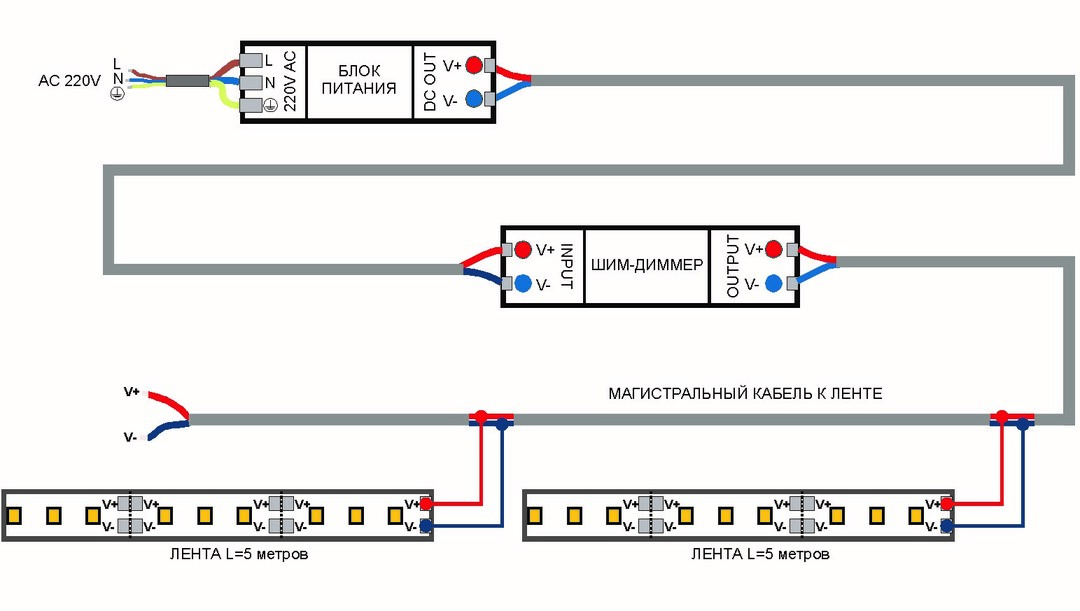
Dimmers can have different designs, but this does not change their place in the general scheme. The device is always installed in the area between the PSU (through the INPUT input) and the LED strips (OUTPUT output)
Adjustable lighting is typically used to illuminate serious structures such as built-in display cabinets or suspended ceilings. Consider an option with a two-tiered plasterboard suspended structure, when the backlight can work simultaneously or separately from the main lighting.
For work, you will need a kit including:
- 4 reels with LED strips;
- dimmer with 4 outputs and remote control;
- power unit;
- cable VVGng;
- installation wires PUGV.
Considering that LED lighting is one of the room lighting circuits, you will also need a junction box and corrugated pipe to insulate the cable in the suspended structure.
Step 1 - connect the power cable
This is the preparatory stage, at which it is necessary to transfer the wire from the switchboard to the junction box in the room, and from there to the power supply. It can take a lot of time and effort, and it is carried out in parallel with the work on the construction of the suspended structure.
All work is carried out in the same way as when installing a conventional switch: we place the cable in the strobe, then we put it into a mounting box, right under which we install a socket for the main switch lighting.
Step 2 - we lay the cable from the junction box to the power supply unit
The cable will be inside the false ceiling. It must be remembered that power is constantly connected to the LED circuit, since there is no switch, and all control will take place through a dimmer with a remote control.
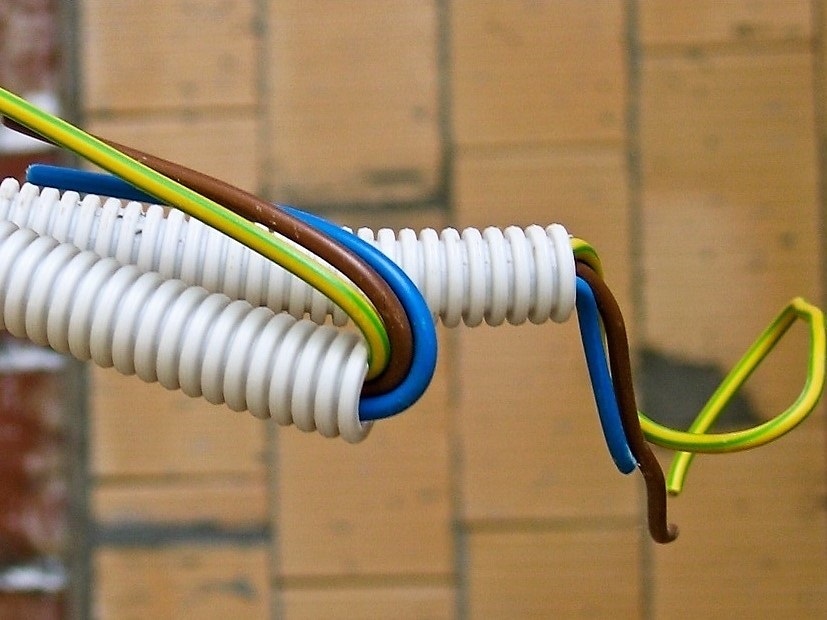
In the under-ceiling space, open wiring is usually used. In this case, additional insulation is needed, with the function of which the corrugated pipe does an excellent job.
The power supply and dimmer must be hidden from view, but accessible for service or repair. For this purpose, a small shelf is suitable, located on the profile in the same place where the LED strip will pass. It is desirable that it is located at a minimum distance from the junction box.
Step 3 - connect the PSU and dimmer
Using wires PGV 1 mm², we connect the power supply unit and the dimmer. You will need a pair of conductors with different colors of insulation: conditionally red will connect the contacts with the "+" sign, black - "-".
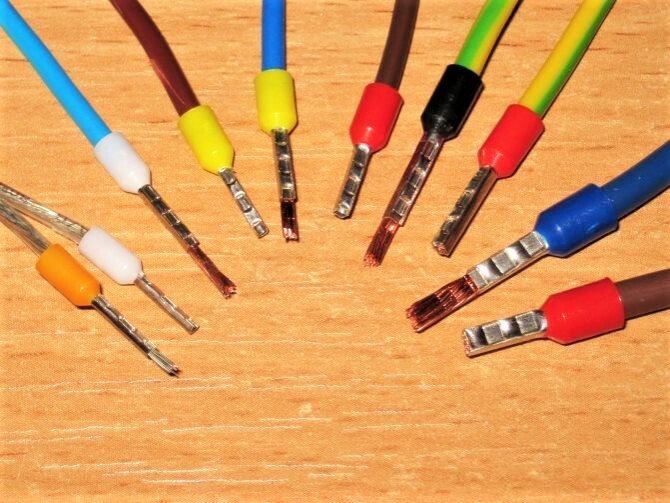
PGV is a stranded wire, therefore, for ease of installation and maximum safety, we recommend using terminal lugs of a suitable shape
We chose a dimmer with 4 outputs, hence it has 1 V + (for red wire) and 4 V- (for black wires).
We connect the wires to both devices, clamping the terminals in the terminals and observing the polarity.
Step 4 - lay the wires from the dimmer to the tape
It is better to determine 2 places for connecting LED strips and place them in opposite corners of the suspended structure - diagonally. From each of their 2 points there will be 2 parallel-connected tapes (4 pieces in total).
The number of red and black wires is different: we pull 1 red and 2 black wires from the dimmer to each of their 2 nodes. Therefore, 2 red and 4 black wires fit to the dimmer.
What are we doing? We connect both red ones with one tip and clamp them in the V + terminal, and insert the black ones one at a time and fix them in the V- terminals, of which there are also 4.
At the same stage, they usually finish mounting the suspended structure, so all that remains is to fix and connect the LED circuits.
Step 5 - connecting LED strips
According to the scheme, the ribbons will depart in pairs from two opposite corners, thus, a closed rectangle of illumination will be obtained.
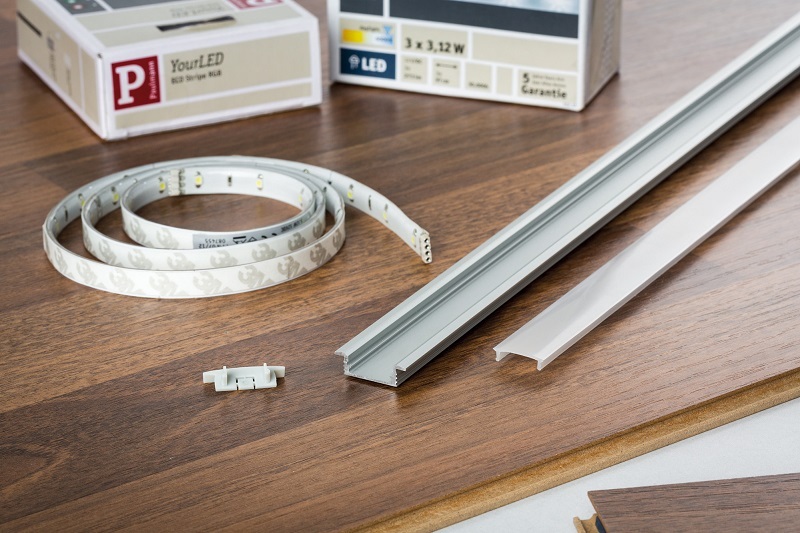
To mount the tape, you need to purchase a special aluminum profile. It performs the installation function and is responsible for heat dissipation when the backlight is turned on.
We cut off pieces of tapes of the required length according to the markings so that there are areas for connection on both sides. They indicate the polarity of the wires. We connect the wires from the dimmer to the tape using soldering or special connectors.
First, we make the commutation in one node, then in the second. After connecting, install the backlight in the profile. To cover it, we glue a decorative baguette to the suspended structure.
Step 6 - testing the lighting system
We carry out testing when the work is done on the main lighting, that is installation of spot / pendant lights or chandeliers. Checking the functioning of the LED backlight, turn on all kinds of modes on the remote control one by one, change the intensity.
If the ribbons are very long, then you will notice that at the ends the glow brightness is noticeably lower. To avoid this, a tape connection scheme is implemented on both sides.
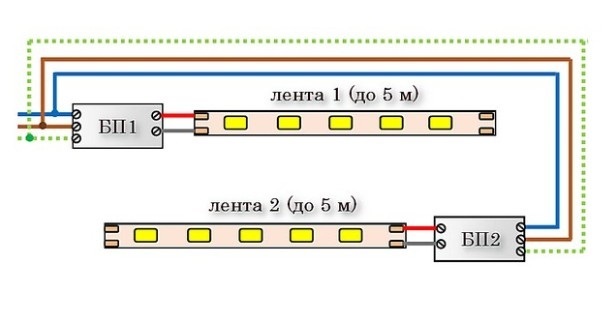
It so happens that the power of one power supply unit is not enough to connect 2 or more circuits. Then you can use several power supplies, connecting 1 tape to each of them.
Remember that the maximum length of each tape is 5 meters. On longer sections, the combustion intensity decreases, and they serve much less. For the same reason, it is impractical to use a serial connection.
When choosing a power supply, be sure to consider the properties of all connected tapes. Power supply parameters must exceed their total power.
Conclusions and useful video on the topic
Three important installation principles:
Instructions from professionals - everything on the shelves:
Soldering LED strip - clearly and according to the rules:
With the installed LED lighting, the appearance of the room changes noticeably. It is perfect as evening lighting or simply as a decorative frame for interior items.
Do you use LED products for design or purely practical purposes? Leave a description and photos of your projects in the comments.
We are also interested in what difficulties do you face during the installation process? Ask questions to our experts and other site visitors, share interesting opinions and suggestions - the feedback form is located below the article.


